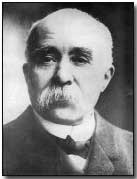Primary Documents - Georges Clemenceau on the Battle of Caporetto, October 1917
 Reproduced below is the
text of French Prime Minister
Georges
Clemenceau's highly critical reaction to news of a major
Italian defeat at the
Battle of Caporetto (also
referred to as the Twelfth Battle of the Isonzo).
Reproduced below is the
text of French Prime Minister
Georges
Clemenceau's highly critical reaction to news of a major
Italian defeat at the
Battle of Caporetto (also
referred to as the Twelfth Battle of the Isonzo).
Such was the scale of the setback (some 300,000 Italian casualties) that Italy's Allies - namely Britain and France - were obliged to rush reinforcements to prop up the Italian front against further setback at the hands of combined German/Austro-Hungarian forces.
In the wake of Caporetto the Italian Army Chief of Staff Luigi Cadorna was dismissed and Armando Diaz installed as Army Chief the Staff.
Click here to read Cadorna's official communiqué announcing Italian defeat at Caporetto. Click here to read an account of the decision to launch the attack by the German liaison officer attached to the Austrian Army, General von Cramon. Click here to read a memoir of the battle by the Chief of the British Red Cross in Italy, G.M. Trevelyan.
Georges Clemenceau on Italian Defeat at Caporetto
Let us consider the military aspect of the Italian situation.
To begin with, the principal error of the Italian high command - alone sufficient to bring about the catastrophe - was the faulty disposition of its armies.
The Second Army, after crossing the Isonzo, was drawn up facing northward on the high mountains of Mzli, Monte Nero, and Vrich, without having reached the crests, which were still in possession of the enemy.
The Third Army, on the other hand, had conquered the crests and held Cucco, Monte Santo, and Vodice. It faced eastward and had advanced across the Bainsizza Plateau toward Laibach.
But between these two armies the Austrians still held a whole sector which formed from Tolmino to Santa Lucia a kind of outpost separating the Italian forces.
Military critics had already drawn attention to the danger of this situation and pointed out that the strategic arrangements of both Italian armies might be thrown into confusion by the enemy if the latter, holding the intermediate high ground, should decide to attack on both sides with sufficient forces.
That is precisely what happened when the Germans were able to transfer part of their troops from Russia to the Italian Alps.
The second error: Behind these armies, drawn up in so perilous a position, there were at least reserves ready in case of a surprise. In May, 1916, in the course of the Austrian offensive in the Trentino, General Cadorna had profited by a moment of respite to constitute the Fifth Army a reserve.
It was the intervention of this force at the critical moment that forced the enemy to retreat. For reasons that we are unable to understand, this Fifth Army was dissolved one fine day: Not that man power was wanting; it was and still is plentiful in Italy. The reserves of man power were numerous enough to furnish other armies as well.
But the Italian Generalissimo has always seemed unwilling to keep them near the front. So, when need came, they could not intervene, and thus the rout of the Second Army, followed by the beating up and precipitate retreat of the Third, carried everything away.
This error is connected with several others, all of which are to be explained by blind confidence in the solidity of the conquests made. Otherwise, what excuse is there for the mistake of massing all the plain supply depots at so short a distance from the front, between Isonzo and the Tagliamento? To take the case of wheat alone: More than 300,000 tons thus fell into the hands of the famished enemy.
How, too, are we to excuse the complete lack of entrenchments, in view of a possible retreat, and the fact that not a single road of retreat was prepared, or a single bridge - beyond five old ones - thrown across the Tagliamento?
The congestion produced almost from the outset by the enormous mass of men and material on the river banks, all trying to cross at the same moment, cost the Italian Army almost as dearly as the sudden loss of all its supply sources which had to be left to the enemy.
Source: Source Records of the Great War, Vol. V, ed. Charles F. Horne, National Alumni 1923
"Bully Beef" comprised cans of boiled or pickled beef used by the British Army.
- Did you know?
